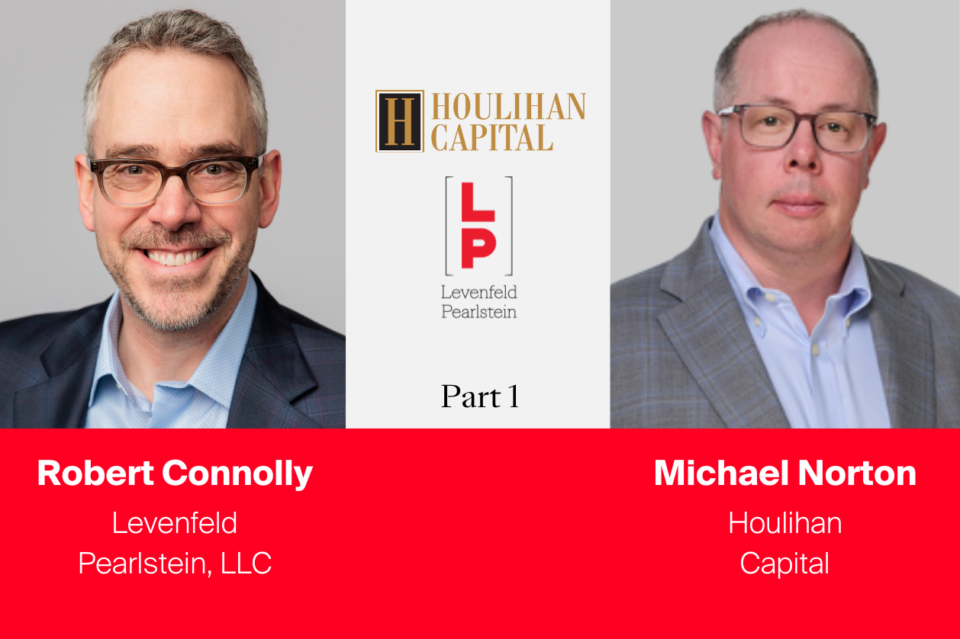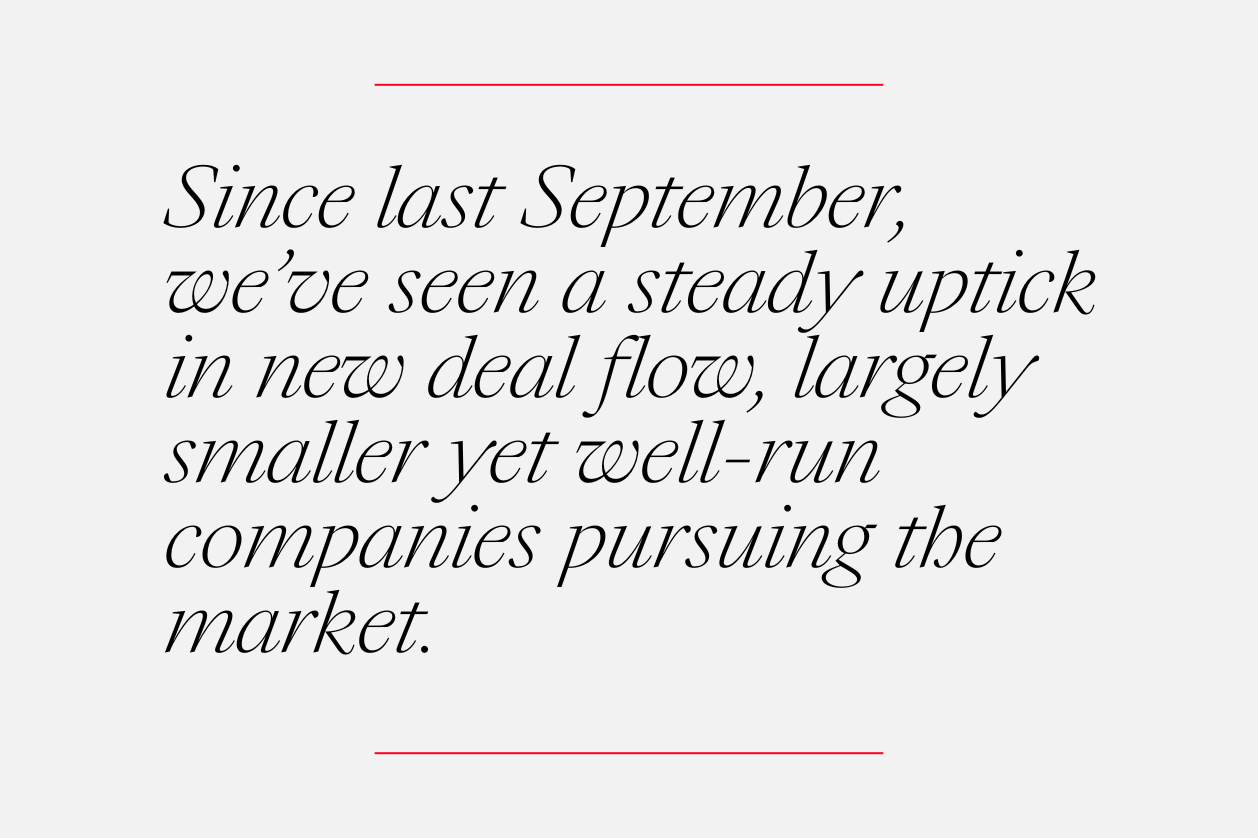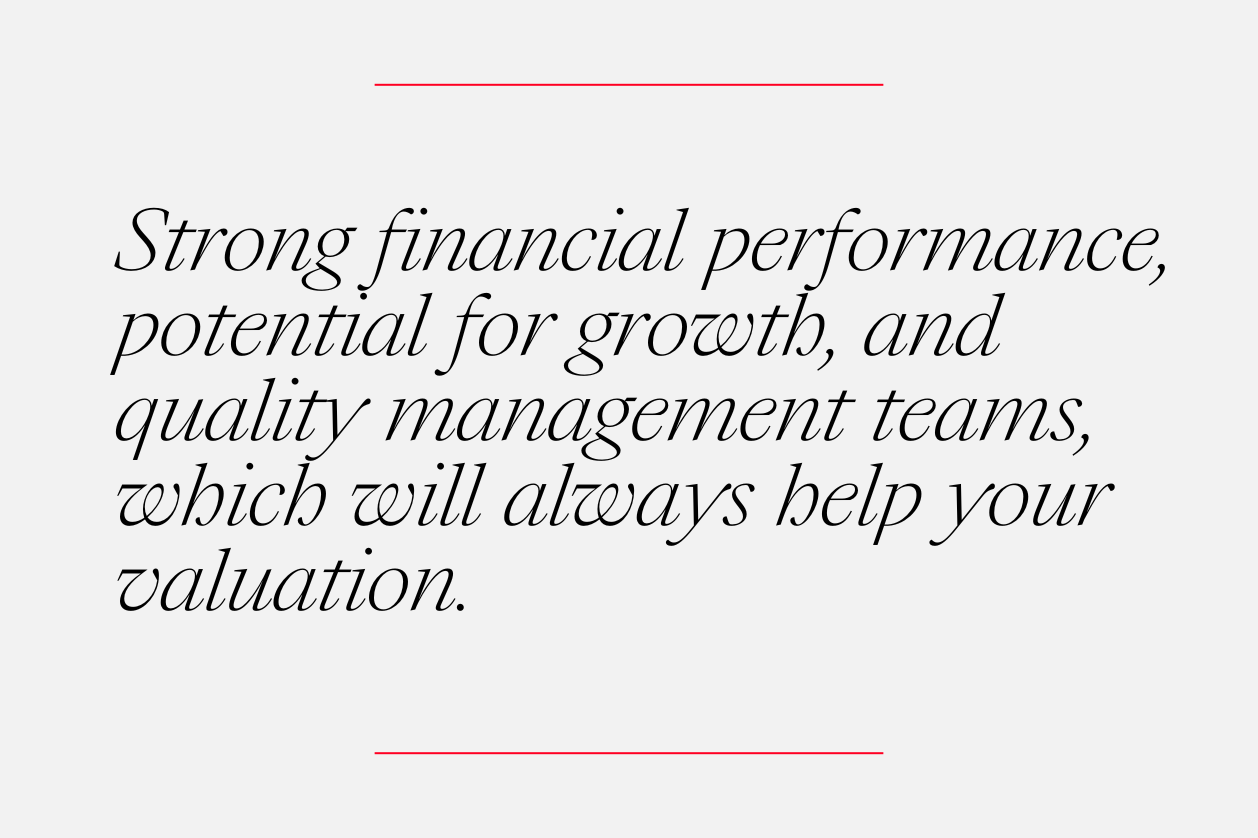Valuation Trends, Buyer-Seller Dynamics, and Advice for Sell-Side Businesses: A Conversation with Michael Norton of Houlihan Capital (Part 1)

To help businesses, investors, and deal professionals better understand the evolving M&A market, Robert Connolly—a partner in LP’s Corporate Practice Group—shares a series of conversations with M&A experts.
Below is his conversation with Michael Norton, Director of Business Development at Houlihan Capital, a solutions-driven valuation, financial advisory, and investment banking firm. In this Q&A, Michael delves into valuation and deal trends, buyer-seller dynamics, and advice for sell-side businesses.
The responses below have been edited slightly for brevity and clarity.
How would you describe the current state of the lower middle market?

At Houlihan, we focus on founder- and family-owned companies, $5-200 million of enterprise value, with EBITDA of $750,000 to high teens of EBITDA, so that’s the market that I’m focusing on. The overall market perspective is that it’s active yet measured. It’s good-busy. We’re not stretched too thin, and there’s steady deal flow despite some economic uncertainty. Some things that have been thrown out by the new administration, such as tariffs, are leaving uncertainty out there.
I think both buyers and sellers are being cautious, but opportunistic. Since last September, we’ve seen a steady uptick in new deal flow, largely smaller yet well-run companies pursuing the market.
For the larger companies with high-single-digit EBITDAs up into the teens, we’ve started to see more conversations and pitch activity, but they are still lagging a little bit. Those deals tend to be more niche or resilient, whether because of steady cash flow or it’s a well-run business.
That cautiousness will spill into the deal-making process as well, with an increased focus on due diligence and time spent assessing the strategic long-term value of the asset. Everyone is hedging for what could or could not occur because of the macro-level uncertainty.
What are some key trends you’re seeing in the market?
One of the key trends we’ve seen in the market is increased consolidation through roll-ups, with private equity starting small and doing buy-and-builds from the strategic buyer universe. They have been slow to sell assets, so there were some liquidity issues. They have a lot of dry powder, but because previous funds have yet to roll off, there’s been some confusion. But through roll-up consolidations, we’re seeing several larger shops dipping down and being more robust with the buy-and-builds.
Both strategic and financial buyers are focusing a lot of their attention on well-run companies where they can bring operational efficiencies to the table. In the age of AI and other technological advancements, it has become cliché for buyers to say they focus on digital transformation, but that has become more of the standard and less cliché. There are efficiencies and ROI to be had by taking some older, less sophisticated companies and improving them significantly on the digital and technological side.
Stable cash flow sectors and “old world” industry are also two areas with a lot of focus. Healthcare businesses, essential services businesses, and recurring services businesses have been a priority for buyers, but we have also seen an uptick in “old world industries,” such as transportation, logistics, trucking, warehousing, and manufacturing, which hadn’t seen a lot of activity in 2022-2024.
Are there any hot sectors or industries right now?

No one’s going to be surprised that we still see activity with essential services and other recurring business services, like facility services. That’s been a trend for the last couple of years. I’ve joked that if you’re representing a client in the HVAC space, the landscaping space, fire and life safety, etc., and there isn’t some focus on exploring the market, you aren’t getting good advice because those areas are so hot right now.
Healthcare has also remained active over the last couple of years—not the same volume as in 2021 and mid/early 2022, but it still remained active. There has been a lot of activity in some subsectors of specialty physician practices, such as med spas and medical aesthetics. We’ve also seen renewed interest in dental.
There had been many very large roll-ups in that space several years ago, and the interest waned a little because of multiples, which have remained high.
The new wave of industrial activity has been fantastic. Those “old world” industries are not as susceptible to huge peaks and valleys in valuation. Buyer interest has moved there because those businesses aren’t going to command huge multiples. They command fair multiples, and from a financing perspective, they’re a bit easier to do because there are real assets with a lot of history. We’re looking at several very old manufacturing businesses right now where they can point to how they’ve absorbed many different waves of economic uncertainty, which gives the buyer a lot of comfort.
Additionally, there’s buyer interest in businesses that aren’t tech-enabled right now, where the buyer can create a tech-enabled business as a way to scale.
Are there any kinds of deals that are becoming more prevalent?
One of the informal ways of judging the market has come from our valuation arm’s perspective. We do a lot of purchase price allocations for opening balance sheets for buyers, and in the roll-up strategies, we’re seeing a lot of deals incorporating earn-outs from the buyers. It’s rare now that we do a deal without some form of contingent consideration. They’re relatively reasonable for both sides because the buyers want to bridge a gap in valuation, and the sellers want something achievable.
Where are valuations trending? What factors may be driving multiples?
Valuations have been relatively stable year over year, with some moderate growth supported by solid cash flow metrics. We’re getting far more competitive bidding processes right now. There’s still a dearth of assets in the market, so if you have one, that will boost your valuation, but many buyers are still going for a relatively smaller grouping of C+ to B+ assets. That’s going to drive values, which are up slightly, and we have seen some of the financial buyers finally start selling off assets because they have a bit more money to work with and some more flexibility, which drives up valuations. To say we’re returning to 2021 levels is just not true, but they’re getting better year over year.

The big drivers with valuation multiples are the things we’d expect to drive multiples up, such as strong financial performance, potential for growth, and quality management teams, which will always help your valuation. If you have a strong management team, that reduces some perceived risk, and it also allows for an easier transition. Even with those sellers who want to exit, we’re very honest about the expectations of a 12-24-month horizon. If a seller wants to leave tomorrow, they shouldn’t expect a premium valuation. There is uncertainty in the market, and seller involvement is a way to get around that.
Interest rates influence pricing and structure, but some sector-specific trends are materializing with the new administration. Part of the move to industrial is a move to onshore. That will probably escalate should any of the proposed tariffs proceed. There may also be some healthcare reforms that may affect some of the healthcare deal flow. As those take shape, it will directly impact multiples.
Lastly, while I’m not a tax expert, the Trump tax plan’s effect on capital gains and other taxes could continue to drive multiples. People may want to exit in 2025 or get a deal done in 2025 because we’re still operating under the 2017 Trump tax plan, and we don’t quite know what will happen with the tax code going forward. Selling in 2025 is one way to hedge against uncertainty.
For more information on Michael Norton, view his bio. For more information on Houlihan Capital, visit their website.
Interested in participating in a future interview series? Please contact Robert Connolly at rconnolly@lplegal.com.
Filed under: Corporate
Related insights
March 18, 2025
Insurance-Related Trends, Risks, and Recommendations for Private Equity Transactions: A Conversation with Ryan Seager at Associated (Part 2)
Read MoreFebruary 24, 2025